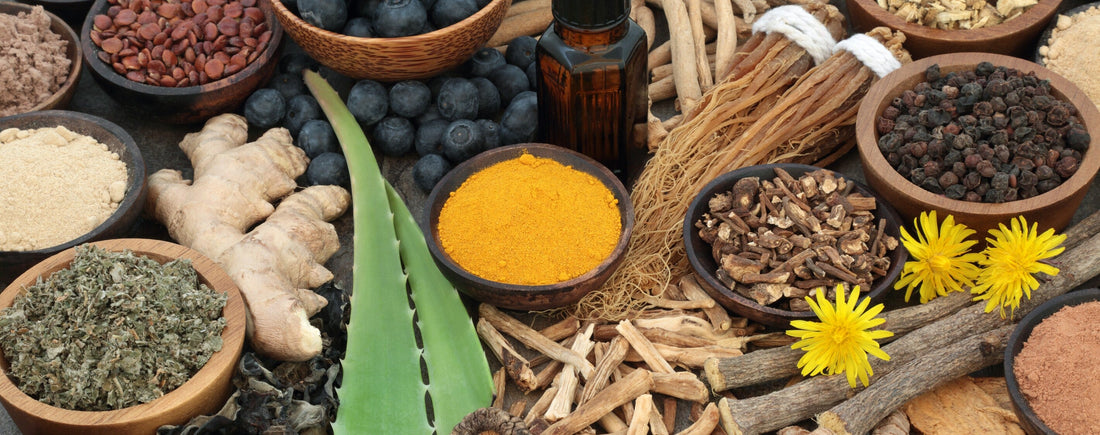In Ayurveda, as well as in all traditional healing systems, the ancient healers and seers did not see humans and nature as separate entities. The foundations of healing were rooted in the idea that we are intimately connected to nature, and that nature, including the plant world, can facilitate our healing.
Ayurveda describes almost 20,000 plants with medicinal potential and documented their benefits thousands of years ago. It has an extremely sophisticated categorization of plants, instructions on preparation of plants for medicinal purposes, and an understanding of combining various plants to synergize or maximize their benefits. Rather than dismiss this wisdom or pick and choose pieces out of a complete system of healing, we can look to Ayurveda and its plant pharmacy for a firm holistic foundation and guidance on the best use of these plants as we navigate health and wellbeing in our modern world.
In my career as a physician over the last 28 years, I have seen the boom of pharmaceuticals and their therapeutic power, but I have also witnessed the era of overuse of prescription drugs and the significant side effects that can also occur. As I began to learn more about traditional healing systems and herbal medicine, specifically Ayurveda, I was fascinated by the fact that when using an herb for a specific benefit, there were many ‘side benefits’ as opposed to ‘side effects’.
For example, when using an herb to facilitate sleep, we can also balance hormones. An herb that is used for digestive symptoms can also help heal the skin. A plant that was considered detoxifying can support the liver as well as offer antimicrobial effects. In nature’s wisdom, plants are naturally packaged with a variety of phytonutrients that benefit our physiology in a myriad of ways. One plant can have hundreds of molecules that interact with receptors on our organs’ cells, as well as intracellularly, and can stimulate our own innate healing mechanisms in multiple ways at the same time. In fact, the interactions of multiple plant molecules with our own cellular receptors can be far more beneficial, and less harmful, than concentrating on one molecule for a singular effect without truly understanding the long-term implications. That’s not to say that medications aren’t needed at times but minimizing their use when there are herbal options has allowed me to truly help my patients heal and thrive while minimizing complications.
Plants and herbs act similarly to food by supporting us at many physiological levels. In this way, herbal medicine has many potential applications. In addition to treating or preventing disease or symptoms, plants can be used as nourishment to keep us healthy when we are feeling well. Part of maintaining good health is having a healthy and functioning detoxification system. Our body is constantly processing molecules that have the potential to cause harm and converting them to forms that we can eliminate. In this regard, there is a growing body of research on the medicinal use of plants for support of our natural detoxification process so we can stay healthy over time.
Support a healthy mind, body, and spirit with the Chopra Renew & Restore Detox Kit. A 7-day Ayurvedic cleanse blending ancient wisdom with modern science. Click to learn more.
There are now specific mechanisms of action being delineated that tell us how herbs and plants support our health and that validate the ancient descriptions of their benefits, specifically as it applies to detoxification. Our innate detoxification pathways allow us to remove molecules from the body that may cause harm or interfere with our self-healing mechanisms. We are constantly coming into contact with environmental chemicals that act as toxins to our physiology, through our air, water, and food. If not eliminated, they can create chronic inflammation, act as carcinogens and mutagens, and cause hormone and microbiome disruption. Although we do have natural mechanisms to detoxify these molecules, we are often depleted of the vitamins, minerals, and nutrients that are necessary for those biochemical reactions to occur.
In medical school we learned that there are ‘rate-limiting’ steps along a biochemical pathway and if the proper molecules are not available, that pathway will not function optimally. And in addition to biochemical pathways, when the channels to eliminate these toxins are not functioning optimally, we don’t actually rid ourselves of these toxins. Detoxification is a multifactorial process and plants are well suited to support us in these processes.
Categories of molecules that are especially useful in the detoxification process include flavonoids, glycosides, saponins, tannins, fatty acids, amino acids, and specific antioxidant and sulfur compounds. Optimal levels of Vitamin C, Vitamin E, several B vitamins, copper, magnesium, zinc, among others are critical to effectively detoxify. In addition, herbs that facilitate natural elimination allow the toxins to be eliminated effectively through the gut while supporting the microbial environment in the intestines with fiber and other nutrients.
Ayurvedic herbs that are classically used during detox contain many of these supportive molecules. Here are just a few components in specific Ayurvedic herbs that support our natural detoxification processes:
As this list demonstrates, when used together, as in typical Ayurvedic detoxification processes, these herbs synergize to support our innate detoxification pathways in multiple ways, at all levels of the process. Many of the specific compounds communicate with our genes to influence genetic expression through epigenetic mechanisms (in the example of curcumin). These epigenetic effects can ‘turn down’ the expression of genes related to inflammation, and they can ‘turn up’ genes related to detoxification. In fact, many molecules in plants can both ‘up-regulate and ‘down-regulate detoxification genes to fine tune and modulate the multiple chemical reactions occurring during the detox process.
Ayurveda has described a complete process of detoxification that includes herbs, as well as other practices, to optimize the elimination of harmful substances from our body. When looking to these ancient practices and beginning to understand their mechanisms of action, we can allow nature, and the plant world, to serve as our ultimate nourishment and healing.
Support a healthy mind, body, and spirit with the Chopra Renew & Restore Detox Kit. A 7-day Ayurvedic cleanse blending ancient wisdom with modern science. Click to learn more.
Ayurveda describes almost 20,000 plants with medicinal potential and documented their benefits thousands of years ago. It has an extremely sophisticated categorization of plants, instructions on preparation of plants for medicinal purposes, and an understanding of combining various plants to synergize or maximize their benefits. Rather than dismiss this wisdom or pick and choose pieces out of a complete system of healing, we can look to Ayurveda and its plant pharmacy for a firm holistic foundation and guidance on the best use of these plants as we navigate health and wellbeing in our modern world.
Nature’s Medicine
In my career as a physician over the last 28 years, I have seen the boom of pharmaceuticals and their therapeutic power, but I have also witnessed the era of overuse of prescription drugs and the significant side effects that can also occur. As I began to learn more about traditional healing systems and herbal medicine, specifically Ayurveda, I was fascinated by the fact that when using an herb for a specific benefit, there were many ‘side benefits’ as opposed to ‘side effects’.
For example, when using an herb to facilitate sleep, we can also balance hormones. An herb that is used for digestive symptoms can also help heal the skin. A plant that was considered detoxifying can support the liver as well as offer antimicrobial effects. In nature’s wisdom, plants are naturally packaged with a variety of phytonutrients that benefit our physiology in a myriad of ways. One plant can have hundreds of molecules that interact with receptors on our organs’ cells, as well as intracellularly, and can stimulate our own innate healing mechanisms in multiple ways at the same time. In fact, the interactions of multiple plant molecules with our own cellular receptors can be far more beneficial, and less harmful, than concentrating on one molecule for a singular effect without truly understanding the long-term implications. That’s not to say that medications aren’t needed at times but minimizing their use when there are herbal options has allowed me to truly help my patients heal and thrive while minimizing complications.
Plants and herbs act similarly to food by supporting us at many physiological levels. In this way, herbal medicine has many potential applications. In addition to treating or preventing disease or symptoms, plants can be used as nourishment to keep us healthy when we are feeling well. Part of maintaining good health is having a healthy and functioning detoxification system. Our body is constantly processing molecules that have the potential to cause harm and converting them to forms that we can eliminate. In this regard, there is a growing body of research on the medicinal use of plants for support of our natural detoxification process so we can stay healthy over time.
Support a healthy mind, body, and spirit with the Chopra Renew & Restore Detox Kit. A 7-day Ayurvedic cleanse blending ancient wisdom with modern science. Click to learn more.
Plants and Detoxification
There are now specific mechanisms of action being delineated that tell us how herbs and plants support our health and that validate the ancient descriptions of their benefits, specifically as it applies to detoxification. Our innate detoxification pathways allow us to remove molecules from the body that may cause harm or interfere with our self-healing mechanisms. We are constantly coming into contact with environmental chemicals that act as toxins to our physiology, through our air, water, and food. If not eliminated, they can create chronic inflammation, act as carcinogens and mutagens, and cause hormone and microbiome disruption. Although we do have natural mechanisms to detoxify these molecules, we are often depleted of the vitamins, minerals, and nutrients that are necessary for those biochemical reactions to occur.
In medical school we learned that there are ‘rate-limiting’ steps along a biochemical pathway and if the proper molecules are not available, that pathway will not function optimally. And in addition to biochemical pathways, when the channels to eliminate these toxins are not functioning optimally, we don’t actually rid ourselves of these toxins. Detoxification is a multifactorial process and plants are well suited to support us in these processes.
Categories of molecules that are especially useful in the detoxification process include flavonoids, glycosides, saponins, tannins, fatty acids, amino acids, and specific antioxidant and sulfur compounds. Optimal levels of Vitamin C, Vitamin E, several B vitamins, copper, magnesium, zinc, among others are critical to effectively detoxify. In addition, herbs that facilitate natural elimination allow the toxins to be eliminated effectively through the gut while supporting the microbial environment in the intestines with fiber and other nutrients.
Ayurvedic herbs that are classically used during detox contain many of these supportive molecules. Here are just a few components in specific Ayurvedic herbs that support our natural detoxification processes:
- Rhubarb root (Rheum rhabarbarum) — Vitamin C, resveratrol, chromone glycosides, polyphenols including gallic acid
- Aloe vera (Aloe barbadensis) — Vitamin C, folic acid, copper, magnesium, zinc, saponins, fatty acids including campestrol and lupeol
- Turmeric (Curcuma longa) — magnesium, tannins, polyphenols including curcuminoids
- Kutki (Picrorhiza kurroa) — phenolic glycosides including picein and androsin
- Neem (Azadirachta indica) — amino acids, sulfurous compounds, flavonoids such as azadirachtin and nimbin
- Gokshura (Tribulus terrestris) — multiple flavonoids, quercitin, tannins, saponins, including sulfated saponins
- Amalaki (Emblica oficinalis) — flavonoids, tannins such as emblicanin-A and emblicanin-B, antioxidants such as quercetin
- Psyllium Husk — fiber and polyphenols such as lignin
- Flax Seed (Linum usitatissimum) — copper, phenols, flavonoids, fatty acids, Vitamin C, Vitamin B1, B2, and B6.
- Triphala — Vitamin C, tannins, amino acids, flavonoids such as quercitin, rutin, luteolin
As this list demonstrates, when used together, as in typical Ayurvedic detoxification processes, these herbs synergize to support our innate detoxification pathways in multiple ways, at all levels of the process. Many of the specific compounds communicate with our genes to influence genetic expression through epigenetic mechanisms (in the example of curcumin). These epigenetic effects can ‘turn down’ the expression of genes related to inflammation, and they can ‘turn up’ genes related to detoxification. In fact, many molecules in plants can both ‘up-regulate and ‘down-regulate detoxification genes to fine tune and modulate the multiple chemical reactions occurring during the detox process.
Ayurveda has described a complete process of detoxification that includes herbs, as well as other practices, to optimize the elimination of harmful substances from our body. When looking to these ancient practices and beginning to understand their mechanisms of action, we can allow nature, and the plant world, to serve as our ultimate nourishment and healing.
Support a healthy mind, body, and spirit with the Chopra Renew & Restore Detox Kit. A 7-day Ayurvedic cleanse blending ancient wisdom with modern science. Click to learn more.






















